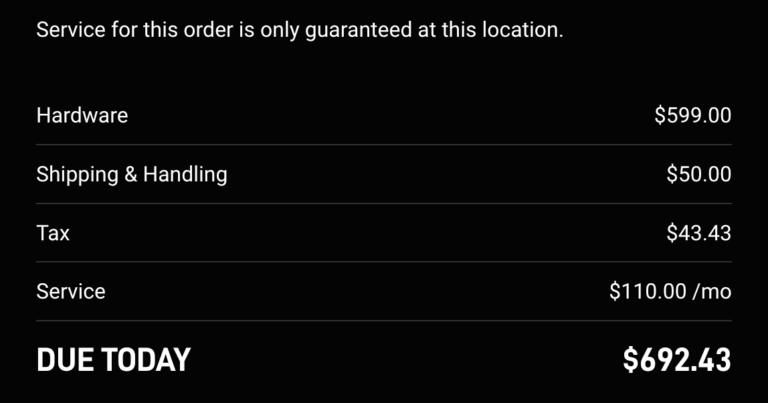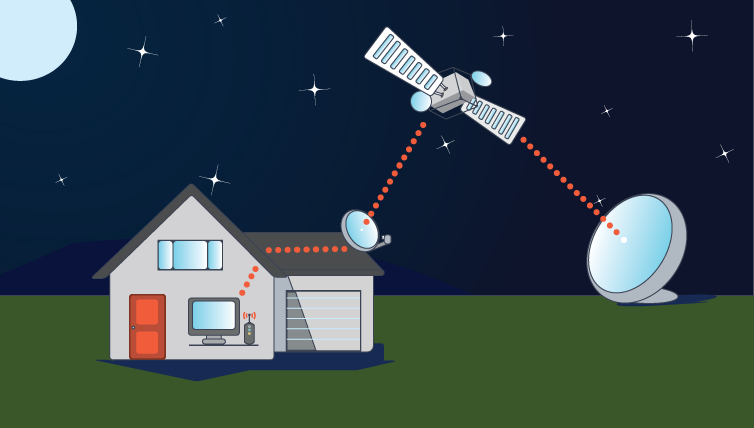Go to Reviews.org AU Edition
The Best Satellite Internet Providers 2023
We compared prices, download speeds, and data caps, and found Viasat as the best choice for fastest speeds and most data, while HughesNet could be a cheaper option and Starlink is one to watch.
We may earn money when you click our links.
The best rural satellite internet providers fully available in the US right now are Viasat (formerly Exede) and HughesNet, but Starlink is definitely an up-and-coming provider to watch.
Out of the two, Viasat is the fastest satellite internet with speeds up to 150 Mbps and unlimited data options.
HughesNet, on the other hand, starts at $74.99 a month (after 6 months) for slower speeds of 15–50 Mbps and smaller data caps.
SpaceX’s Starlink is finally out of beta, though its only residential satellite internet plan is over $100 a month and only available in 33 states. But features like unlimited data and fast advertised download speeds make it worth keeping an eye on Elon Musk’s satellite venture.
If you’re still hung up on which provider is best for you, we understand. Sometimes it’s not as cut and dried as price versus speed when it comes to satellite internet. Let’s dig into the features so you can choose the best satellite internet provider for your needs.
Why are there only three satellite internet providers?
Many of the old satellite internet companies discontinued their service or were bought by another company, leaving Viasat and HughesNet as your two main options. At least for now, while we wait for Starlink service to reach its full potential.
That said, if you’re looking for alternative ways to get rural internet, we’ve got a few different options in our guide to the best rural internet service.
- Viasat: Service is currently available in the US.
- HughesNet: Service is currently available in the US.
- Starlink: Beta testing is officially over, and if Starlink isn't available in your area you can pay a refundable $99 deposit as service is built out to new areas.
- OneWeb: Just received more funding from Hanwha Systems Co. out of Seoul, South Korea, and will start crafting its second generation of spacecraft.5 OneWeb has launched 648 satellites so far.
- Project Kuiper (Amazon): Amazon is actively hiring Project Kuiper–related roles and recently opened a new lab space in Redmond, Washington.6
Discontinued satellite internet providers
- Exede Internet: Changed its name to Viasat
- WildBlue satellite internet: Bought by Exede in 2009
- dishNET: Discontinued
- EarthLink: Discontinued
Is satellite internet right for you?
Heads up: Satellite internet is nowhere near as good as cable or fiber internet, and isn't as good as some DSL internet. It’s the sad truth, but for some of us, it’s the only kind of internet we can get.
Even so, internet providers are expanding their networks all the time, and new, local providers continue to crop up. So it’s worth looking to see if you can get a non-satellite internet provider like AT&T, CenturyLink, Suddenlink (now Optimum), or even a smaller, local provider.
But if satellite is truly your best hope for a reliable internet connection, here are a few things to consider before you subscribe.
5 things you should check when buying satellite internet
- Download speeds and upload speeds and whether they meet your needs
- How much data comes with the plan, whether it’s enough data for you, and if you can add more data
- Whether satellite internet’s latency will negatively affect your online activities
- The cost of equipment and installation
- Availability of plans
1. Download and upload speeds
First up, you likely won’t get very fast download speeds—Viasat’s and Starlink’s download speeds are the fastest at 150 Mbps respectively.
On the other end of that spectrum, you won’t get fast upload speeds with satellite internet. Viasat and HughesNet advertise 3 Mbps upload speeds—that’ll make uploading a YouTube video or other large file a fairly lengthy process. And Starlink's residential plan's upload speed is barely better at around 5 Mbps.
2. Data caps
Similarly, most satellite internet plans don’t come with a lot of data. (Starlink currently offers unlimited data, but that may change in the future.) That means you’ll need to watch your data usage, especially when you stream Netflix, download video games, or join Zoom calls.
Some providers let you add data, like HughesNet, but you’ll end up paying more.
3. Latency
And don’t forget about latency. Satellite internet is known for its high latency, which means it takes longer for anything you do online to communicate with the satellite, get a response from the website you’re visiting, and then communicate back to your computer. That makes certain activities, like gaming and Zoom calls, laggy.
It's worth noting the reliability of satellite internet service. In the event of a natural disaster like a tornado or earthquake, for instance, satellite internet service can't be interrupted by broken cable connections.
Because Starlink uses a different satellite technology than Viasat or HughesNet, it features lower latency. Basically, its satellites are closer to the Earth, so it takes less time for your signal to reach the Starlink satellite and travel back.
4. Equipment and installation fees
Satellite internet equipment can cost more than the equipment that comes with a DSL, cable, or fiber internet plan. That’s because, along with a modem, you’ll need a satellite dish (also called a receiver).
Monthly rental fees for your satellite equipment aren’t too bad, but if you’d rather buy the equipment outright, you’re looking at a cost of $300 to $500, depending on which provider you go with.
On top of that, you’ll need a professional installer to set up your dish if you go with Viasat or HughesNet. (Starlink has a self-installation kit.) That usually costs around $100, but sometimes free installation promos are available.
Don’t forget too, that if you ever need to move your satellite dish to a new location, it’ll cost you. Viasat’s dish relocation fee is $200—that’s a hefty price.
5. Availability
Though satellite internet is technically available across the whole US, you may find that certain plans or prices aren’t available in your area. This is even more true for newcomer Starlink, which is still launching satellites and rolling out its service.
Your best bet is to check which plans are available by entering your zip code below or by calling the provider you’re interested in.
HughesNet: Cheapest prices for slow speeds
HughesNet’s small data cap plans offer excellent value when it comes to price for the speed you get—and your cost doesn’t go up after three months. (We’re giving Viasat the side-eyes right now.)
HughesNet plan pricing
HughesNet’s plans are also simpler to sift through when compared to Viasat’s smorgasbord of choices. Not that we dislike a lot of choices, but simplicity and straightforward pricing is also great.
HughesNet’s prices start out extremely reasonable—but with lower data and similar pricing, it isn't much more value than Viasat’s low-data plans. And those prices are set in stone for your 2-year contract. But unfortunately, your starting cost skyrockets once you put any plan over 15 or 100 GB in your shopping cart.
That’s why we recommend HughesNet as a cheap alternative to Viasat, but only for the 15 and 100 GB plans.
HughesNet equipment pricing
HughesNet offers you a chance to either rent your equipment or pay the full price up front. Either way, your HughesNet equipment costs are fairly comparable to Viasat.
Data effective 4/4/2023. Offers and availability vary by location and are subject to change.
HughesNet’s price to purchase your equipment went up, and now it’s likely more cost effective to rent. But don’t be caught off guard by a $99 lease setup fee that you’ll need to pay as well as your installation (unless you get a free installation deal).
In addition to budget-friendly small-data plans, here are a few more reasons to give HughesNet a good, long look.
Options to add more data
Although it doesn’t offer unlimited data plans, HughesNet knows you don’t always use the same amount of data every month. So instead, it lets you buy data tokens to add anywhere from 3 to 25 GB of extra data to your account.
HughesNet data token prices
- 3 GB: $9
- 5 GB: $15
- 10 GB: $30
- 25 GB: $75
We cover all the steps to buying data tokens in our HughesNet data guide, so give it a read if you’re coming up short on data at the end of the month.
PS: Your HughesNet data token won’t expire. We’re doing a happy dance because HughesNet lets your data tokens rollover if you don’t use them up right away.
Of course, the cost of extra HughesNet data can add up quickly. If you find that you’re constantly buying more data just to watch Obi-Wan Kenobi on Disney+, you might want to swap to a different provider or check out the HughesNet Bonus Zone (which we’ll get to next).
Free Bonus Zone data
The HughesNet Bonus Zone gives you an extra 50 GB of data, but you’ll need to stay up until 2 a.m. to 8 a.m. your time to use it. But if you can keep your eyes open that long, it’s well worth it for a free chunk of data.
And for comparison’s sake, it’s worth knowing that Viasat doesn’t offer anything similar to the HughesNet Bonus Zone. (At least that we’ve seen.)
Great speed performance
HughesNet has a reputation—a reputation for giving you more speed than what it advertises. That’s a huge blessing, because faster speeds are never a bad thing. (Unless you’re paying extra money for them.)
Not to mention that HughesNet was faster on average than Viasat, even with Viasat’s faster maximum speed of 150 Mbps.
Is HughesNet internet good?
There’s something to be said for HughesNet’s excellent speed performance and clearly labeled plans (each one is named after how much data you get). Not to mention, it doesn’t spike your price after three months like Viasat.
But because HughesNet’s plans all come with 15–50 Mbps download speed and its data caps are much lower than Viasat’s, you might prefer Viasat if you need faster speeds and more data.
Viasat: Fastest satellite internet speeds and most data
Viasat is the best way to max out your download speeds and not worry about data overages, thanks to its unlimited satellite data plans. Surprisingly, Viasat’s packages are sometimes a better deal than HughesNet when you consider the speed and data you get. Of course, you’ll still pay a pretty penny to get those max speeds of 150 Mbps along with Viasat’s largest data allowance.
Viasat plan pricing
Viasat’s internet plans will squash your internet speed down to 1–5 Mbps once you use up all your data—but since Viasat's plans offer unlimited data, whichever plan you choose should have you covered, even if it isn't always high-speed. Did we imagine that dial-up connection noise?
Prices and availability vary by location. Installation fees, monthly equipment lease fees, and taxes may apply. After 100 GB of High-Speed Data usage, you still have unlimited access to Standard Data, which may result in slower speed.
With Viasat's unlimited data plans you get a data “soft” cap.
That means if you use up all of your data allowance, your internet speed might get throttled to 1–5 Mbps during times where there’s lots of online traffic. We don't think you'll have to worry much about hitting your soft data cap, though, since the cheapest plan, Discovery 25, starts by offering 100 GB of high-speed data.
Still, the unlimited data plans offer the most data and fastest internet speeds by far—even compared to HughesNet.
Your monthly Viasat bill will go up after three months
The introductory pricing you get when you sign up for a Viasat plan lasts only three months. After that, you’ll be paying standard pricing and your bill will increase anywhere from $20 to $50 per month depending on your plan.
Viasat does offer a 2-year price lock guarantee, so your “standard pricing” will stay the same for 24 months after you activate your service. But just be aware that the advertised price you see for Visasat plans is not what you’ll be paying long-term.
Viasat equipment pricing
As for equipment costs, Viasat offers two ways to pay for your satellite dish and router. You can pay the full price up front or rent it for a monthly fee.
Data effective 4/4/2023. Offers and availability vary by location and are subject to change.
If you go with Viasat, you’ll need to lease your equipment for about $13 per month. You can also go with a lifetime lease for a one-time fee of $299.99.
If you plan to have your equipment for more than 30 months, the lifetime lease can save you some money. But you should also know that it’s not the same as purchasing equipment because you still have to return your equipment if you ever cancel your service.
Along with the fastest max speeds, here are a few other perks Viasat offers:
- Unlimited data plans
- Cheaper Liberty plans
- EasyCare service program
Fastest satellite internet speeds
Viasat currently maxes out at 150 Mbps download speeds, which puts it miles ahead of HughesNet’s max speed of 50 Mbps and even beats Starlink’s residential top-end speed of 100 Mbps.
That’s enough speed to connect lots of devices to the internet: cell phones, tablets, smart TVs, your home security system—you name it. You might also get to stream in HD or 4K, but watch your data usage.
We should mention, though, that Viasat ranked just below HughesNet in our look at the fastest ISPs in the US. This could be attributed to HughesNet’s 15–50 Mbps speeds since Viasat speeds start at 12 Mbps.
Unlimited data plans
If you’re after unlimited satellite data, Viasat is the way to go.
Though you technically don’t get unlimited high-speed data, you do still get a hefty high-speed data allowance each month (up to 1 TB). And if you happen to use all your data, your speeds get slowed—but only if there’s a lot of internet traffic.
If you need the most priority data Viasat has to offer, go with the Discover 150 Unlimited plan. It comes with 1 TB of data each month, not to mention 150 Mbps download speeds.
Cheaper limited data plans for light internet users
Only need a little bit of internet to check your email and Facebook? Then Viasat’s Discovery 25 Mbps plan might be more your speed—and price.
This plan offers up to 35 Mbps download speeds, plus unlimited data. And you can add more data to your Viasat plan.
Is Viasat internet good?
Servicing your satellite internet isn’t an easy task. There are a lot of things that go into positioning your dish in just the right way, not to mention hooking everything up to your home.
If something goes wrong, a service visit could cost you $95. But if you enroll in Viasat’s EasyCare program, it’s free (though the program costs $8.99 a month). (And we found the Viasat EasyCare program refreshingly simple compared to HughesNet’s similar Express Repair program.)
We recommend Viasat as our first choice for satellite internet thanks to its wide range of download speeds and large data caps. You’ll want to watch out for the 3-month price hike, though, which makes Viasat’s already high prices soar even higher.
You might not see all of Viasat's plans in your area
Since satellite internet can support only so many users, some Viasat plans aren't available in certain areas. Thankfully, Viasat is well on its way to launching yet another satellite fleet, ViaSat-3, in early 2022.12 The new constellation of three total satellites will offer tons more bandwidth, meaning it should support more people who need rural internet access.
Starlink: New satellite provider to watch
Starlink is continuing to extend its service across the US and Canada, and it’s looking like a viable satellite internet option for lots of folks. Some areas still can’t get Starlink service, though by the end of 2023 Starlink plans to be available everywhere.
And if Starlink is available in your area, expect to pay a fairly steep up-front cost. Along with your monthly service cost of $110, you’ll need to pay at least about $600 plus shipping and handling to get your satellite dish.
And all that comes with unlimited data (for now), zippy speeds, and low latency. (Satellite internet usually has high latency, which can look like a laggy connection.)
Data effective 4/4/2023. Offers and availability vary by location and are subject to change.
We mentioned before that Starlink equipment costs a hefty sum—$599 up front, to be exact. On top of that, you’ll have to pay the shipping and handling fee to have your satellite dish and modem sent to you.
And for any real big spenders out there, Starlink recently released its High Performance hardware, which costs an even steeper $2,500. The High Performance hardware is meant to have better satellite visibility, almost two times better snow-melting capabilities, and three times better speeds at more extreme temperatures
Our shipping and handling added up to $50. So you’re not looking at too steep a cost there, especially when you consider you can self-install Starlink and avoid what’s usually about a $100 installation fee for satellite internet.
- Starlink satellite dish and modem cost: $599 + shipping and handling
The only thing is you can also buy a lifetime lease for your satellite receiver and modem from Viasat for $299.99 or buy your equipment from HughesNet for $499.98. Or you can rent from either of those providers instead, if forking over a few hundred dollars isn’t in your budget.
With Starlink, there is no equipment rental option (yet), but hopefully, that gets added in the future. And SpaceX is fully aware of how costly its equipment is for those of us interested in beaming Starlink from our own homes.
SpaceX president and chief operating officer Gwynne Shotwell has noted that Starlink aims to cut the cost of its satellite dish and modem by about half.8 We bet you agree that paying around $250 for your user terminal is much easier to swallow than $600.
But even with that mountainous up-front cost, Starlink still boasts a lot of great features.
Professor Alan Woodward of England noticed several small outages while using Starlink.9 He blames pigeons, which seem to think the dishie on top of his kitchen roof is a bird bath.
If you’ve also got some curious pigeons hanging about, try some humane deterrents like plastic predators or light and sound devices to keep them away.
Low latency
Starlink’s satellite internet latency sits around 20–40 ms, while typical satellite internet latency sits around 594–612 ms on average.1
That could be the difference between a smooth, frustration-free Zoom call with your boss versus your sound lagging out and you missing out on critical information. Or scoring the winning play of the game in Overwatch and lagging out so bad you get roflstomped by the enemy team.
Starlink is able to get such low latency thanks to its low Earth orbit (LEO) satellites, which sit lower in Earth’s orbit than Viasat’s or HughesNet’s satellites. And with the addition of laser terminals and crosslinks to all future satellites, Starlink hopes to reduce latency even further.8 Laser crosslinks will reduce the satellites’ reliance on ground stations by requiring fewer connections between the satellites and ground stations.
Potentially lower prices
While you can get a HughesNet or Viasat plan that costs less than $110, those plans for sure won’t come with unlimited data.
So once you’ve paid the up-front cost for the Starlink “dishie” satellite receiver, you’re looking at a potentially lower price for satellite internet.

But we do wish Starlink had an equipment rental option like HughesNet and Viasat. The steep $599 cost of your Starlink dish and router (not to mention the $2,500 hardware option or shipping and handling fees) might mean the difference between someone connecting to Starlink’s potentially superior speeds … or not.
Unlimited data
Right now, Starlink promises you’ll never hit a data cap. That could change in the future, but if you’re able to take advantage of the unlimited data now, that’s a huge win.
Is Starlink better than Viasat?
Because Starlink is barely out of its beta stage, it's difficult to compare performance. However, as far as price goes, Viasat has unlimited data plans that can provide plenty of data to users without ever nearing Starlink's price tag.
Apart from Starlink, no other satellite internet provider currently offers a data cap that even comes close to unlimited data. The next biggest data cap comes from Viasat’s Discovery 150 Unlimited plan, which offers 1 TB of high-speed data before slower speeds.
Is Starlink internet good?
Since Starlink is still so new, it’s hard to say definitively whether it’s good or not. A look at Starlink speeds in early 2021 show that it’s getting faster, but with a few dips in median download speeds in February and June.3 Overall, Starlink’s median download speed for the second quarter of 2021 reached 97.2 Mbps, which allows you to do most any kind of modern online activity.
There’s also the issue of Starlink receivers shutting down due to extreme heat.4 That might seem like an issue that affects only a small group of people, but not having internet for half a day or more due to weather can really put a kink in your plans. (Trust us, we sat without internet for whole afternoons at a time due to bad storms in Georgia.)
Even so, Starlink is still very new, which means things could improve in the future. And even in beta, this new satellite internet provider is offering what could be a better option for folks in rural areas.
Recap: What are the best satellite internet providers?
The best satellite internet providers that are available in most rural areas are Viasat and HughesNet.
Viasat is a great pick if you want to get the fastest possible satellite internet speeds and unlimited data, while HughesNet offers excellent value in the form of lower prices for slower speeds and lower data caps.
The best satellite internet for rural areas
- Viasat: Fastest satellite internet speeds. When it comes to satellite internet, Viasat’s max 150 Mbps download speeds are as good as it gets. And compared to HughesNet, which might be your only other option, you get more data and the chance at higher speeds for your money.
- HughesNet: Cheap satellite internet plans. HughesNet is a great pick if you’re more concerned about your monthly bill than you are about download speeds or data caps. Even with lower prices, HughesNet offers an okay 15–50 Mbps download speed with all its plans, plus 15 to 200 GB of data. (And options to add more.)
- Starlink: A satellite internet newcomer to watch. Starlink isn't as available as Viasat and HughesNet, but its promised speeds of up to 100 Mbps and lack of data caps make it a big improvement over other rural internet options. But a big up-front equipment cost could put Starlink just out of reach of some budget-minded folks, and its speeds are lackluster compared to its price.
Methodology
To compare satellite internet providers, we dug into a few different details:
- The price for the speed and data you get
- Whether options to add data are offered
- The cost of equipment
We chose to include Starlink in this review even though its service is fresh from its beta testing phase.
We felt that, despite its limited availability and slow rollout, Starlink brings new features to the satellite internet table that shouldn’t be disregarded. This includes unlimited data, lower latency, and potentially faster download speeds compared to Viasat and HughesNet.
And though Starlink could clearly be a superior satellite internet choice for some, we mainly focused on Viasat and HughesNet as proven satellite providers with countrywide availability.
FAQ
Still not sure satellite internet will work for you? Maybe we can help you decide.

Satellite internet works by sending data from your computer to the satellite dish on your house, then to a satellite sitting in geostationary orbit above the Earth’s equator. Next, that satellite sends your data to your ISP, then all the way back to your computer.
Want to get the full picture? Check out our full guide on how satellite internet works.
Generally, satellite internet speeds range from 12 to 150 Mbps, but how many Mbps you get depends on which ISP and plan you choose.
For HughesNet, you’ve got the option of 25 Mbps download speeds—and that’s it. With Viasat, you can choose anywhere from 12–150 Mbps for your download speed. And Starlink’s max speeds top out near 100 Mbps for its residential plan.
Of course, those are the advertised download speeds. There are a lot of factors that can influence your speed, including your modem and even how many people are using your internet.
If your satellite internet speed is slow, there are a few tips you can try before calling your ISP’s customer service department. Check them out in our video below, or read our guide to speeding up your satellite internet.
All HughesNet internet plans provide 25 Mbps download speed while Starlink's speeds max out at 100 Mbps. Of course, many things like modems and the number of people using the internet can affect your speeds, but we think it's safe to say Starlink is faster than HughesNet.
Most satellite internet connections are pretty reliable even though your dish is outside.
That’s because modern satellite equipment is built with weather in mind, and snow, ice, or rain are usually not a big deal. And even if you lose connection during a bad storm, it should be a short disruption.
Satellite internet is a great rural internet option if you live in an area with no DSL, cable, or fiber internet options. Satellite offers faster speeds than dial-up, though it tends to be pricier than other internet options.
How much you can download depends on your satellite internet plan and data cap. For example, if your plan comes with a 10 GB data cap per month, then that’s about four two-hour HD movies or 180 hours of streaming music.
Check out our list of the online activities that use the most data to figure out how much data you need.
You can absolutely stream both videos and music while using satellite internet. You’ll just want to be careful of your data cap, and both HughesNet and Viasat come with tools to help you do that.
HughesNet automatically adjusts video quality to a lower resolution to help you use less data. Yup, you won’t be watching anything in 1080p. Instead, expect all your Netflix shows to play in 480p.
Viasat offers a Video Data Extender tool that lets you tone down video quality to 480p too. The best part? If you want to watch the new photorealistic version of The Lion King in all (or most of) its glory, you can turn the Video Data Extender off.
Want more details? Check out our guide to streaming with satellite internet.
Yes, you can stream Netflix with satellite internet. All of Viasat’s and HughesNet’s plans come with enough download speed to stream Netflix in standard definition (SD) or high definition (HD). Though we recommend streaming in SD when you can since it uses less data.
If you want to stream Netflix in 4K on satellite internet, be wary of your data cap. You’ll also want one of Viasat’s faster plans that come with 35 or 150 Mbps.
HughesNet’s 25 Mbps speeds are technically enough to stream Netflix in 4K, but you’ll likely see a lot more of the buffering icon than you want to.
Yes, technically you can game on satellite internet. But the full answer is a bit more complicated than that.
Satellite internet isn’t a great choice for gaming because of its notoriously high latency. It takes a long time for your internet signal to reach your house from the satellite hanging out about 22,000 miles in outer space, then back to the satellite and on to the game server.
That’s going to cause a lot of in-game latency, also called “ping” or noted as “MS” on your game interface.
Even Starlink, with its promises of lower latency, ran into issues when people tried to game on it.7
But gaming on satellite internet isn’t all bad news. We’ve got some recommendations and tips in our guide to satellite internet gaming.
Yes, both Viasat and HughesNet will charge you an early termination fee if you cancel your service before your 24-month contract is up.
Viasat early termination fee
With Viasat, you’re stuck paying $15 per month for every month remaining on your contract. For example, if you cancelled your service only a month after installation, it would cost you $345 in early termination fees. It’s not cheap.
On the other hand, you could get your Viasat satellite internet service with no contract. But it’ll cost you $500 up front.
HughesNet early termination fee
If you cancel your HughesNet service after installation but before your contract is up, HughesNet can charge you $15 for every month you have left on your contract, up to $400.
Yes, you can get satellite internet for your RV or boat through a broadband global area network (BGAN). Here we explore all boating wifi options.
But be warned, the equipment and service plans for RV-ready satellite internet will likely be much more expensive than what you’d pay to slap a dish on your cabin roof. Check out all the options in our guide to satellite internet for your RV.
The Starlink dishie is officially ready to get mounted to the top of your RV (or your Tesla, as one inventive driver tried to do10).
And the dish can be used for more than just RVs. Elon Musk said new terminals will be optimized for aircraft, ships, large trucks, and RVs.11 (But they’ll still be too big for smaller cars like your Tesla.)
Yes and no. Viasat advertises unlimited satellite internet plans, but you won’t get truly unlimited high-speed data (though 1 TB is pretty close).
More on Viasat's data policy: Instead of disconnecting your internet service if you go over your data cap, Viasat slows your download speed during times when there’s a lot of internet traffic. We cover more of the details in our Viasat data guide.
Professional installation services and fees vary, so it depends on the satellite provider you choose and on where you live.
For Viasat and HughesNet, you have to choose professional installation. But with Starlink, you’ll get a self-installation kit and use an app to set everything up yourself.
One thing to note: Viasat and HughesNet might offer free installation in one location but charge a fee in another. Most of the time, though, installation should be free.
As for the actual pro installation process, it’s usually done by third-party contractors. So feel free to ask your satellite internet provider lots of questions and make sure to look over the paperwork carefully.
And if you live in a townhouse, condo, or any other living situation with a homeowners association (HOA), double-check that you’re allowed to install a satellite dish before you schedule installation.
Sources
- Starlink, “Frequently Asked Questions,” 2021. Accessed June 29, 2021.
- Starlink, “Starlink Pre-Order Agreement,” 2021. Accessed June 29, 2021.
- Isla McKetta, SpeedTest, “How Starlink’s Satellite Internet Stacks Up Against HughesNet and Viasat Around the Globe” August 2021. Accessed August 13, 2021.
- Jon Brodkin, Ars Technica, “Starlink Dishes Go Into ‘Thermal Shutdown’ Once They Hit 122° Fahrenheit,” June 2021. Accessed June 29, 2021.
- Thomas Seal, Bloomberg, “Musk Rival OneWeb Gets Funding for Next Satellites From Hanwha,” August 2021. Accessed August 17, 2021.
- Amazon Staff, Amazon, “AWS and Project Kuiper are Driving Innovation in Redmond, Washington,” June 2021. Accessed June 29, 2021.
- Reddit, “Starlink Gaming Ping/Stability,” November 2020. Accessed July 16, 2021.
- Jason Rainbow, SpaceNews, “All Future Starlink Satellites Will Have Laser Crosslinks,” August 2021. Accessed August 27, 2021.
- Chris Vallance, BBC News, “Why Pigeons Mean Peril for Satellite Broadband,” August 2021. Accessed September 3, 2021.
- Michael Sheetz, CNBC, “California Highway Patrol Tickets Driver with Apparent SpaceX Starlink Dish Bolted to Car Hood,” July 2021. Accessed September 3, 2021.
- Jon Brodkin, Ars Technica, “SpaceX Previews Ruggedized Starlink Dish for Vehicles, Ships, and Aircraft,” August 2021. Accessed September 3, 2021.
- Viasat, Inc., PR Newswire, “Viasat's First ViaSat-3 Satellite Achieves Major Mileston; ViaSat-3 (Americas) Currently at Boeing Undergoing Final Spacecraft Integration and Testing in Preparation for Launch,” June 2021. Accessed September 23, 2021.
- WGRZ staff, WGRZ, “Viasat Internet Outage Fixed After Train Derailment in Canada Damaged Network,” September 2021. Accessed October 1, 2021.
Related Articles






